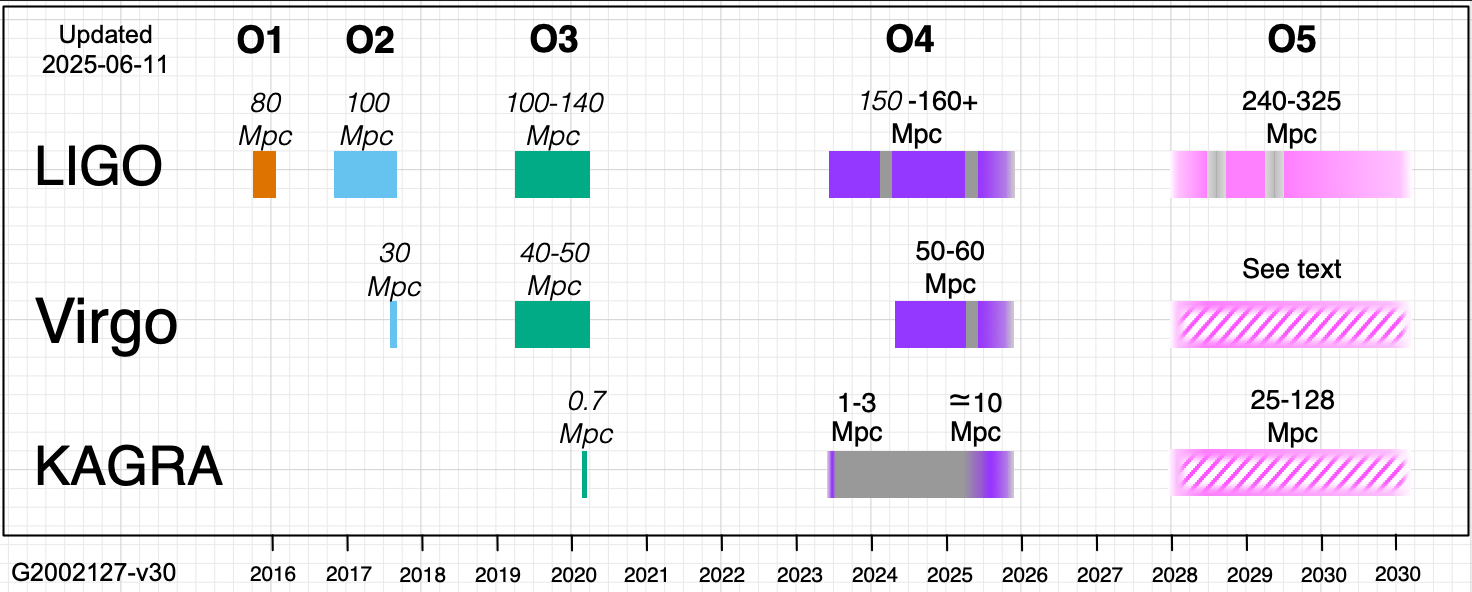Goals
Virgo is a laser interferometer detector managed by the consortium EGO, funded by the CNRS, INFN and NIKHEF, that aims at detecting gravitational waves emitted by astrophysical and cosmological sources. Since 2007, the Virgo collaboration collaborates with the LIGO collaboration in the USA and more recently the KAGRA collaboration in Japan. The teams of the three collaborations analyze jointly their data sets. Since 2015, LIGO, Virgo and KAGRA have been taking data during observation runs interspersed with detector update phases.

The SNO Virgo aims to ensure French participation in Virgo's community activities and the rapid availability of detection data, in particular to the community of French astronomers and astrophysicists. The activities of the SNO concern the development and improvement of the sensitivity of Virgo, the development of the software suite for data analysis and detection of the various sources, the development of automatic analysis software allowing to quickly obtain a position, follow-up and assistance to observers by ensuring that they have all the information from Virgo-LIGO-KAGRA.
Identity
Data
- Calibrated data from Virgo is available for download at https://www.gw-openscience.org/ 18 months after the end of each 6-month observation period.
- The site provides calibrated data from Virgo, LIGO, catalogs of identified and published sources, analysis software, metadata on the quality of Virgo and LIGO data as well as tutorials.
- Virgo auxiliary channel data is not yet available.
OCA involvement
The Virgo group at OCA is involved in many activities:
- Development, construction and installation of a high power laser for Virgo upgrades.
- Development of data analysis pipelines and the search for transient sources and background of GWs in LIGO-Virgo data
- Targeted search for multi-messenger sources (GRBs, giant flare magnetars, etc.) with data from LIGO-Virgo and Fermi-GBM/Swift detectors.
- The construction and the update of the gravitational-wave sources catalog.
- Multi-messenger (EM and neutrinos) follow-up of gravitational-wave sources.
OCA staff involved
M.A. Bizouard, W. Chaibi, N. Christensen, J.P. Coulon, A. Domiciano de Souza, A. Fienga, M. Merzougi, E. Polini, M. Trad-Nery, M. Turconi
The Virgo SNO is performed in collaboration with Virgo members from laboratories associated to the Observatoire de Paris (APC, LUTH).
National executive board
M.A Bizouard (OCA), E. Chassande-Mottin (ObsPM)
The committee is defining the scientific priorities of the service and links with the Virgo collaboration. the committee also helps CNAP candidates for their application.
Short-term needs and prospects
- The team wishes to strengthen its involvement in the scientific exploitation of multi-messenger data.
- The team wishes to strengthen its involvement in the development of signal processing techniques to subtract transient sources of noise from data.
- The team wishes to strengthen its technical support for the high power laser of the Virgo detector.
- The team wishes to strengthen its participation in the production of the catalog of transient sources LIGO-Virgo-KAGRA for runs O4 and O5 and in the release of data from these runs.
- The team wishes to strengthen its involvement in electromagnetic follow-up of gravitational-wave sources with the development of the gravitational-wave alert system of Virgo-LIGO-KAGRA and contribute to this with fast parameter estimation algorithms.


